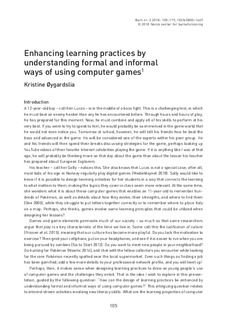| dc.description.abstract | A 12-year-old boy – call him Lucas – is in the middle of a boss fight. This is a challenging test, in which he must beat an enemy harder than any he has encountered before. Through hours and hours of play, he has prepared for this moment. Now, he must combine and apply all of his skills to perform at his very best. If you were to try to speak to him, he would probably be so immersed in the game world that he would not even notice you. Tomorrow at school, however, he will tell his friends how he beat the boss and advanced in the game. He will be considered one of the experts within his peer group. He and his friends will then spend their breaks discussing strategies for the game, perhaps looking up YouTube videos of their favorite Internet celebrities playing the game. If it is anything like I was at that age, he will probably be thinking more on that day about the game than about the lesson his teacher has prepared about European Explorers. His teacher – call her Sally – notices this. She also knows that Lucas is not a special case; after all, most kids of his age in Norway regularly play digital games (Medietilsynet 2018). Sally would like to know if it is possible to design learning activities for her students in a way that connects the learning to what matters to them, making the topics they cover in class seem more relevant. At the same time, she wonders what it is about these computer games that enables an 11-year-old to remember hundreds of Pokémon, as well as details about how they evolve, their strengths, and where to find them (Gee 2005), while they struggle to put letters together correctly or to remember where to place Italy on a map. Perhaps, she thinks, games involve some learning principles that could be utilized when designing her lessons? Games and game elements permeate much of our society – so much so that some researchers argue that play is a key characteristic of the time we live in. Some call this the ludification of culture (Frissen et al. 2015), meaning that our culture has become more playful. Do you lack the motivation to exercise? Then grab your cellphone, put on your headphones, and see if it is easier to run when you are being pursued by zombies (Six to Start 2012). Do you want to meet new people in your neighborhood? Go hunting for Pokémon (Niantic 2016), and chat with the fellow collectors you encounter while looking for the rare Pokémon recently spotted near the local supermarket. Even such things as finding a job has been gamified; add a few more details to your professional network profile, and you will level up! Perhaps, then, it makes sense when designing learning practices to draw on young people’s use of computer games and the challenges they entail. That is the idea I wish to explore in this presentation, guided by the following question: “How can the design of learning practices be enhanced by understanding formal and informal ways of using computer games?” This intriguing question relates to interest-driven activities involving new literacy skills. What are the learning properties of computer games? What are the characteristics of formal learning environments, and how do all of these elements fit together when designing learning practices? My interpretation of this question involves the following central elements: designing learning practices, computer games, and formal and informal use of computer games. As this is an extensive topic, I had to make some choices in relation to focus. First, while many of the principles that inform game-oriented learning design are applicable to all ages, I have chosen to focus here on young people’s use of computer games. This relates to a second choice I have made, which is to center the discussion of designing learning practices on designing for formal learning environments. Finally, I have interpreted formal and informal ways of using computer games as computer game use in formal settings, such as classrooms, and in informal settings, such as playing or making games at home. | nb_NO |

